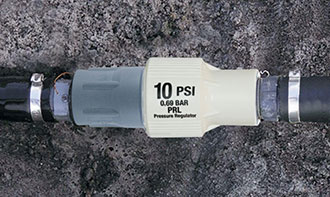
A drip system pressure regulator helps to obtain uniform water distribution throughout the system by maintaining a constant pressure and flow rate. It is a pressure regulator's primary function in any pressurized irrigation method. However, when wondering if you need a pressure regulator for drip irrigation, you must remember that drip installations operate at relatively low pressures. It means that even minor variations in pressure can significantly affect how evenly the system applies water to the crop.
Because the pressure changes can lead to significant differences in water supply from one emitter to the other, we recommend utilizing a pressure regulator for drip irrigation. Also, pressure regulators help lessen system strain and stop drip lines and fittings from blowing apart.
Pressure fluctuations result from energy loss within the pipes, valves and fittings, and elevation changes. Therefore, the use of regulators is critical in fields where the elevation varies considerably.
Pressure can change by 1 psi for every 2.31 feet of elevation variation. The emitters at the lowest position in a field that varies in elevation by 10 feet will be operating at a pressure that is more than 4 psi higher than the emitters at the highest point. That is a rather big variance in a system with a design operating pressure of only 8 psi.
For an irrigation system to achieve proper distribution uniformity, the difference in water application between the emitters with the lowest and highest deliveries shouldn't exceed 10%. All it takes to alter the flow by 10% is a 20% pressure difference. For instance, a pressure variation of 2 psi on an emitter that is intended to function at 10 psi is equal to a 20% pressure variation.
You can control pressure variations on a drip system with pressure regulators or pressure-compensating emitters. Most pressure-compensating emitters maintain a satisfactory distribution uniformity in the operational range of 10 to 30 psi. They do not require a pressure regulator but are significantly more expensive to buy than standard emitters.
In drip systems, there are two typical types of regulators ― preset regulators that have a fixed outlet pressure to match the pressure needs of the emitting devices and adjustable regulators that allow the outlet pressure to be manually adjusted. In general, preset regulators cost less than adjustable regulators.
Fields with varying elevations must be divided into sections with slight elevation differences within each section. Each section would have a pressure regulator installed at the inlet, and the delivery system would be pressurized to maintain sufficient pressure at the regulator in the section with the greatest elevation. The regulators would lessen the increased pressure in all parts with lower elevations, resulting in adequate water distribution uniformity.
Going in-depth into pressure regulator fundamentals
Learn the fundamentals of pressure regulation with Senninger's Guide to Irrigation Pressure Regulator and the free on-demand Pressure Regulation course on Hunter University. Learn how to install pressure regulators in different irrigation systems, select a model, identify wear issues, causes of pressure fluctuations and more.
References
Grabow, G. L., Harrison, K., Smith, W. B., Vories, E., Zhu, H., & Khalilian, A. (2005). Design of subsurface drip irrigation systems in humid areas. In Proc. 2005 World Water and Environmental Resources Congress.
Kizer, M. A. (2013). Drip (Trickle) Irrigation Systems, Oklahoma Cooperative Extension Fact Sheet.

